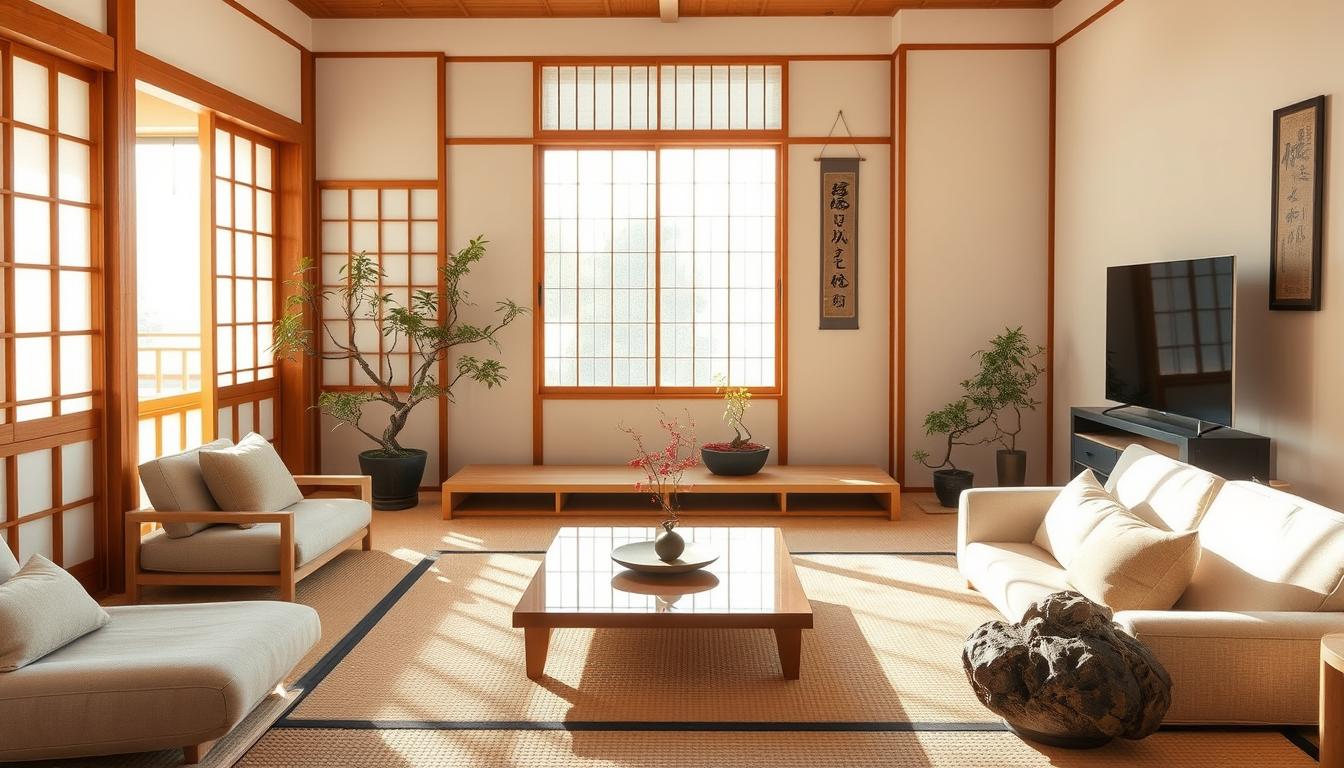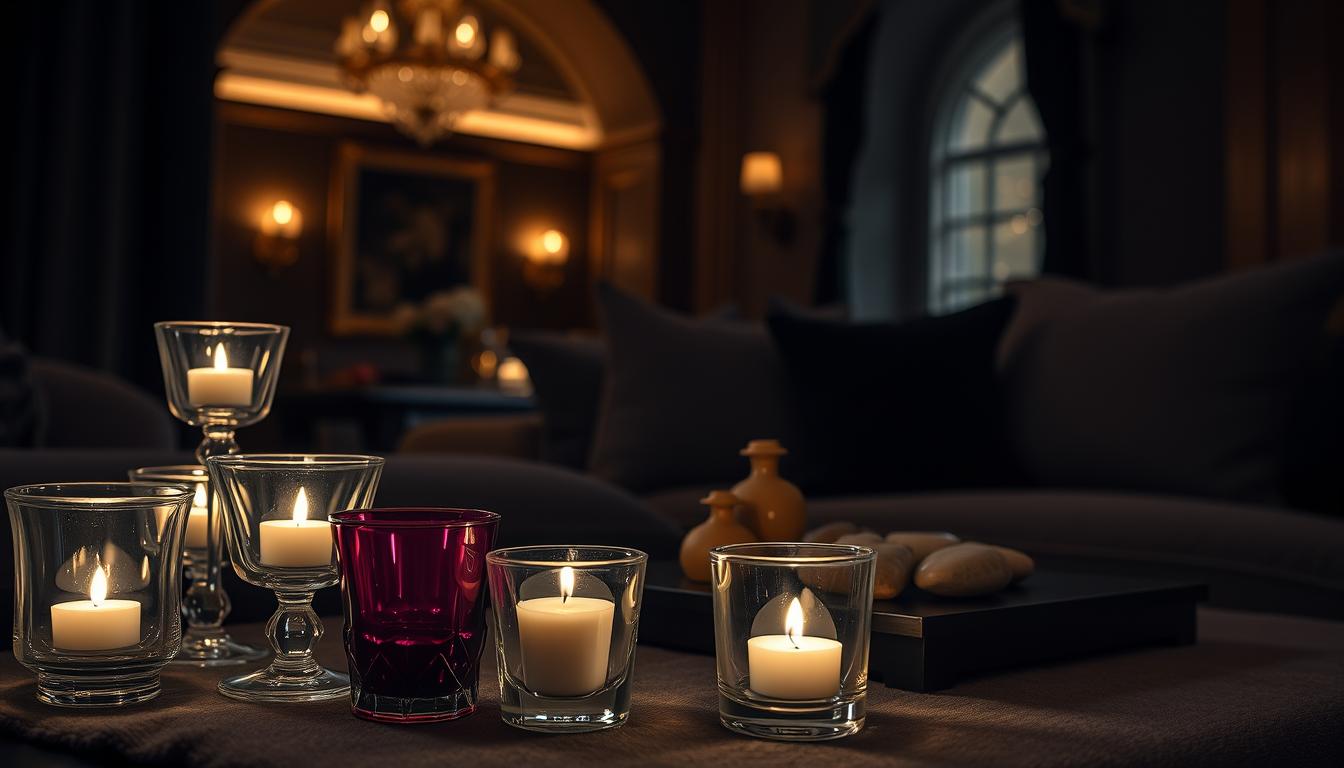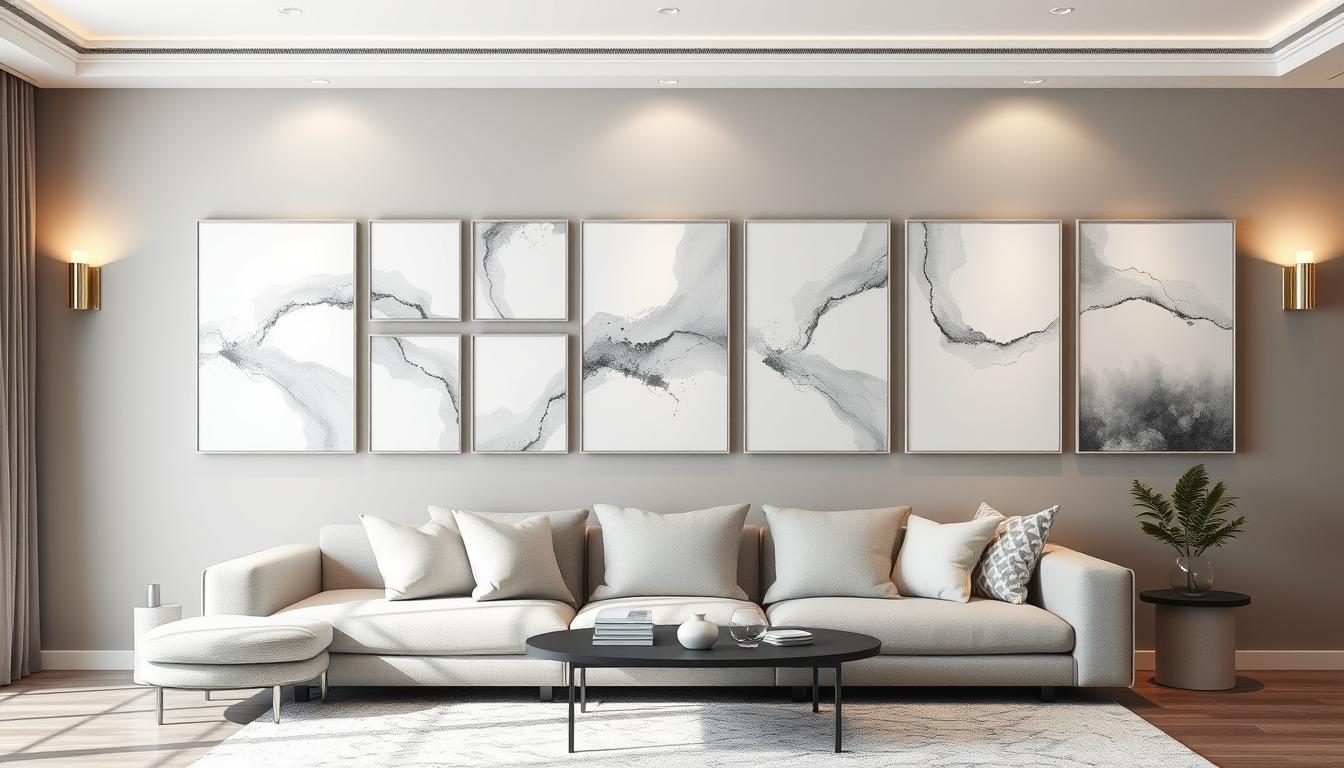In recent years, Japanese interior design has become very popular. Many homeowners love its simplicity and natural beauty.
This guide will show you how to make a peaceful and stylish home. We’ll cover the main elements and give you practical tips. You’ll learn how to create a beautiful modern Japanese home interior.
Key Takeaways
- Understand the core principles of Japanese design
- Learn how to incorporate natural elements into your space
- Discover practical tips for achieving a harmonious living area
- Explore the importance of simplicity in Japanese interior design
- Create a serene and stylish home inspired by Japanese aesthetics
Understanding Modern Japanese Design Principles
Modern Japanese design blends simplicity with a love for nature. It’s not just about looks; it’s a way of life. It values simplicity and harmony.
Minimalism in Japanese Interiors
Minimalism is key in Japanese design. It uses clean lines and focuses on function. Japanese interiors aim for calm and focus, not just less stuff.
Minimalism makes spaces calm and clear. It lets us focus on what’s important. It also helps the planet by using less and choosing items that do more.
The Importance of Nature
Nature is vital in Japanese design. Wood, stone, and plants bring the outdoors inside. This connection boosts well-being and peace.
| Natural Element | Design Application | Benefit |
|---|---|---|
| Wood | Flooring, Furniture | Warmth, Texture |
| Stone | Decorative Accents, Pathways | Durability, Aesthetic Appeal |
| Plants | Indoor Gardens, Green Walls | Purification, Visual Interest |
Balance and Harmony in Space
Balance and harmony are essential in Japanese design. It’s about placing things right to feel balanced. This balance comes from mixing textures, colors, and shapes.
The idea of “Ma” (the space between things) is also key. It shows the value of empty space. This makes objects feel calm and inviting.
Key Elements of Modern Japanese Home Decor
Adding modern Japanese home decor elements can turn your space into a peaceful retreat. We’ll look at how to create this calm by using natural materials, clean lines, and light.
Natural Materials and Textures
Wood, bamboo, and paper are key in modern Japanese decor. They add warmth and make a space feel cozy and welcoming. For example, wooden floors or bamboo blinds can make your home feel more natural.
Using different textures through fabrics, rugs, and furniture is also important. Mixing textures adds depth and interest to a room, making it more inviting and comfortable.
| Material | Characteristics | Uses in Modern Japanese Decor |
|---|---|---|
| Wood | Warmth, durability | Flooring, furniture, wall paneling |
| Bamboo | Sustainability, flexibility | Blinds, furniture, decorative elements |
| Paper Products | Lightness, simplicity | Shoji screens, lanterns, wall decorations |
Emphasis on Clean Lines
Modern Japanese design focuses on clean lines and minimal decoration. This simplicity brings elegance and makes spaces feel open and uncluttered. Japanese-style furniture often has simple, low-profile designs that follow this rule.
By focusing on clean lines, you can make your home feel more spacious and peaceful. This creates a sense of flow and continuity.
Incorporating Light
Light is essential in modern Japanese home decor. It brightens the space and makes it feel welcoming and calm. Using large windows or skylights can greatly improve your home’s ambiance.
In the evening, ambient lighting can create a cozy atmosphere. This enhances the peaceful feel of your living space.
Color Palette Inspiration
Choosing the right colors is key to a modern Japanese home. The colors should bring calm, serenity, and a connection to nature. These are core values of Japanese design.
Earthy Tones and Neutrals
Earthy tones and neutrals are the base of a modern Japanese color scheme. Beige, taupe, and soft grays create a calm atmosphere. These colors are soothing and let natural textures shine.
Pops of Color in Accessories
While the main colors are soft, accessories can add pops of color. Traditional Japanese colors like deep reds and rich blacks are used in items like vases and lanterns. They make the space interesting.
Seasonal Color Adjustments
Japanese design loves to show the changing seasons. You can change colors with the seasons. For example, spring brings pastel colors, while autumn has warmer tones.
| Season | Primary Colors | Accent Colors |
|---|---|---|
| Spring | Soft greens, whites | Pastel pinks, blues |
| Summer | Light woods, creams | Bright yellows, oranges |
| Autumn | Warm beiges, oranges | Deep reds, burgundies |
| Winter | Grays, soft blues | Rich blacks, silvers |
By picking earthy tones, adding pops of color, and adjusting with the seasons, you can make a modern Japanese home. It will feel harmonious and connected to nature.
Furniture Choices for a Modern Japanese Aesthetic
To achieve a modern Japanese look, choose furniture that’s simple and functional. The right furniture is key to this style, which values simplicity, natural materials, and a connection to nature.
Look for furniture that makes your space feel open and flowing. Low-profile furniture helps achieve this. It makes your room look bigger and supports the minimalist vibe.
Low-Profile Furniture
Low-profile furniture is a key feature of modern Japanese design. It keeps the space clean and open by being close to the ground. This design also promotes using space wisely, fitting with Japanese minimalism.
For example, low-seating sofas and coffee tables that sit low on the floor are great. They look good and keep the room feeling open and clutter-free.
Multi-Functional Pieces
Multi-functional furniture is also important in modern Japanese design. These pieces do more than one thing, which helps keep your space tidy and functional. A storage ottoman is a good example. It’s a seat and a place to store things, showing off Japanese design’s practical side.
| Furniture Piece | Primary Function | Secondary Function |
|---|---|---|
| Storage Ottoman | Seating | Storage |
| Shoji Screen | Room Divider | Decorative Element |
| Tatami Mat | Flooring | Defining Space |
Authentic Japanese Influences
Adding authentic Japanese touches to your furniture can make your space more meaningful. Items like tatami mats and shoji screens are both useful and bring traditional Japanese beauty into your home.
Using these items thoughtfully can blend modern and traditional styles. This makes your home a unique reflection of modern Japanese design.
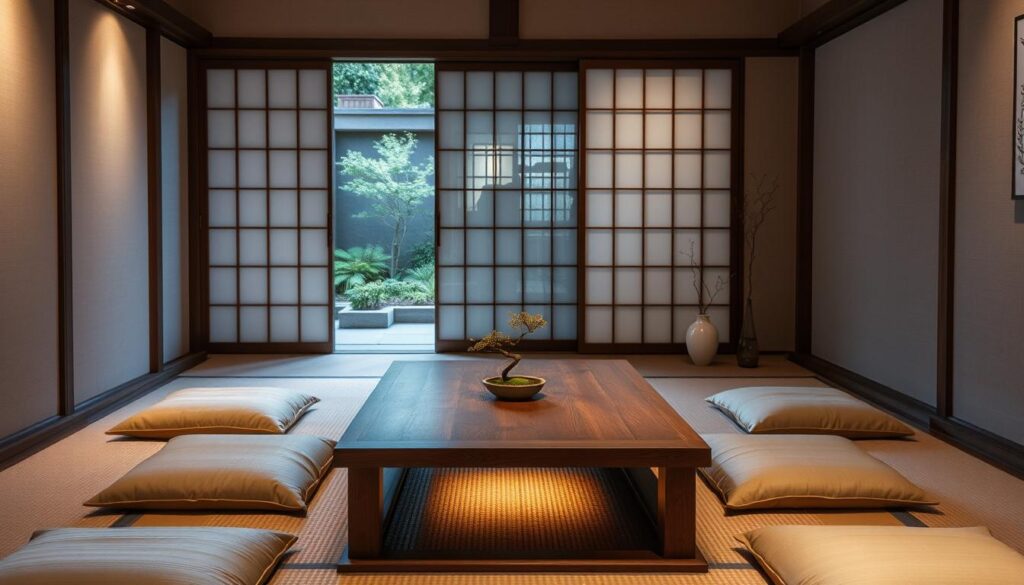
Creating Space for Zen and Relaxation
A Zen-inspired interior is more than just pretty. It’s a way to make our homes peaceful. We can do this by adding design elements that help us relax and feel calm.
Meditation Corners
Having a special spot for meditation can really help our minds. A quiet area with comfy seating, simple decor, and soft lights is perfect. Use a low-seating stool or a cushion on the floor for a traditional Japanese feel.
Indoor Gardens and Shoji Screens
Indoor gardens add a calming touch of nature to our homes. Shoji screens filter natural light, making a soft, peaceful glow. Together, they create a calm space.
| Element | Purpose | Benefits |
|---|---|---|
| Meditation Corner | Dedicated space for mindfulness | Reduces stress, improves focus |
| Indoor Gardens | Bringing nature indoors | Enhances calmness, purifies air |
| Shoji Screens | Filtering natural light | Creates soft lighting, adds elegance |
Use of Water Features
The sound of water can make a room feel more peaceful. A small fountain or water feature adds a calming sound. It helps us relax by creating a soothing background noise.
By adding these elements, we can make our homes beautiful and peaceful. They reflect Japanese design and help us feel relaxed and well.
Designing Functional Living Spaces
A modern Japanese home is all about blending function with sleek design. We aim to make spaces that look great and work well. They should serve more than one purpose.
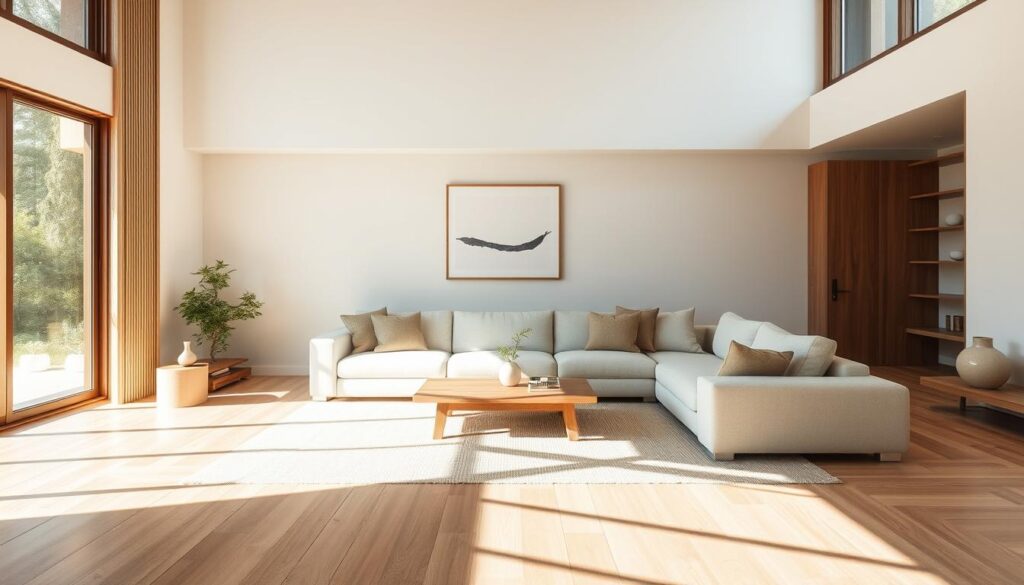
Open Floor Plans
Open floor plans are key in modern Japanese homes. They make spaces feel bigger and more flexible. By cutting down on walls, we get a room that feels open and airy.
This design also lets in more natural light. It makes moving from one area to another feel smooth.
Seamless Indoor-Outdoor Transitions
Modern Japanese design focuses on smooth indoor-outdoor transitions. We use sliding doors and big windows to merge the two. This brings the outdoors into your home.
It looks great and makes your home feel more peaceful. It connects you to nature.
Space-Saving Solutions
Modern Japanese homes often have limited space. We use smart furniture and storage to make the most of it. This keeps things tidy and functional.
| Space-Saving Solution | Description | Benefit |
|---|---|---|
| Multi-functional Furniture | Furniture that serves more than one purpose, such as a storage ottoman. | Reduces clutter and increases functionality. |
| Clever Storage | Storage solutions that are integrated into the design, such as hidden compartments. | Keeps the living space organized and clutter-free. |
| Minimalist Decor | Simple, uncluttered decor that does not overwhelm the space. | Enhances the sense of calm and serenity. |
By using these ideas, we create homes that are both useful and lovely. They show off the beauty of modern Japanese design.
Lighting Elements in Japanese Interiors
Lighting in Japanese interiors shows a deep understanding of mood and perception. It’s not just for light; it’s a key element that boosts the space’s look and feel.
Natural Light Utilization
Maximizing natural light is a core principle of Japanese design. Homes use large windows and sliding doors made of paper or glass. This lets sunlight in, reducing the need for artificial light during the day.
This approach saves energy and connects the home to the outdoors.
Natural light utilization is vital in Japanese design. It showcases the beauty of natural materials in homes.
Importance of Ambient Lighting
As night falls, ambient lighting becomes key for a warm, inviting atmosphere. Japanese interiors use soft, warm lighting for coziness. This is done with lanterns, paper lamps, or light fixtures that spread the light.
“The gentle glow of ambient lighting can transform a space, making it feel more intimate and serene.”
Unique Fixture Designs
Lighting fixtures in Japanese interiors focus on simplicity and elegance. Traditional lanterns and lamps with paper shades add character. These fixtures light up the room and show off Japanese craftsmanship.
By using these elements, homeowners create a lighting scheme that’s both useful and beautiful. It follows the principles of contemporary Japanese decor.
Styling with Japanese Art and Decor
To get a true Japanese feel, it’s key to add traditional art and decor thoughtfully. Japanese art goes beyond looks; it’s tied to the culture and spirit of Japan.
Calligraphy and Traditional Artworks
Calligraphy and traditional artworks are big in Japanese decor. Calligraphy, or “shodou,” is seen as a top art form in Japan. It shows the artist’s spirit. Traditional artworks, like ukiyo-e woodblock prints, bring history and culture to the space.
Modern Interpretations of Craftsmanship
Modern takes on traditional craftsmanship are also important in Japanese interiors today. Modern designs mix old techniques with new materials and styles. This creates a unique blend that respects the past and welcomes the present.
| Traditional Craft | Modern Interpretation |
|---|---|
| Hand-carved wooden furniture | Sleek, minimalist wooden designs |
| Intricate ceramic pottery | Modern ceramic pieces with simple, elegant designs |
Importance of Cultural Artifacts
Cultural artifacts, like old furniture or traditional ceramics, add depth and meaning. These items are more than decorations. They connect us to Japan’s history and culture.
Choosing and showing these items carefully helps create a space that truly reflects Japanese culture. It also makes our zen-inspired interiors even more special.
Sustainable Practices in Japanese Home Design
A modern Japanese home is all about living in harmony with nature. It uses sustainable materials and practices. This not only helps the environment but also makes living better.
Eco-Friendly Materials
Using eco-friendly materials is key in making a sustainable home. Bamboo, recycled wood, and low-VOC paints are good choices. They’re good for the planet and make your home healthier.
Bamboo is fast-growing and can be ready in just three to five years. It’s great for floors and furniture. Reclaimed or recycled wood adds charm and supports sustainability.
Energy Efficiency Moves
Energy efficiency is crucial in Japanese home design. Using energy-saving appliances, LED lights, and smart tech cuts down energy use.
Traditional Japanese design also helps. Shoji screens control natural light, reducing the need for artificial light. This mix of old and new makes homes both stylish and green.
Biophilic Design Elements
Biophilic design connects us to nature. Adding indoor gardens, green walls, and natural stone improves well-being. It makes the indoors feel like outdoors.
Using natural materials like wood and paper strengthens this connection. It brings the outdoors into our homes, making them more sustainable and peaceful.
In summary, sustainable practices are vital in Japanese home design. They create homes that are beautiful and good for the planet. By choosing eco-friendly materials, saving energy, and using biophilic design, we can make homes that honor tradition and support sustainability.
Final Touches for a Modern Japanese Home
Creating a sleek Asian-inspired space is all about detail and understanding cultural nuances. We’ve learned the importance of minimalism, natural materials, and choosing accessories wisely. These elements help us craft a contemporary Japanese decor.
Accessories and Textiles
Choosing the right accessories is key to adding elegance without clutter. Opt for minimalist decor that shows off Japanese design’s simplicity and sophistication. Textiles like tatami mats and futon covers add warmth and texture, making your space cozy.
Personalizing Your Space
Personalization is crucial to make your modern Japanese home unique. Add personal items that reflect your style to make your space feel authentic and welcoming. By blending tradition with personal touches, you create a serene and harmonious living space that captures the essence of Japanese interior design.

